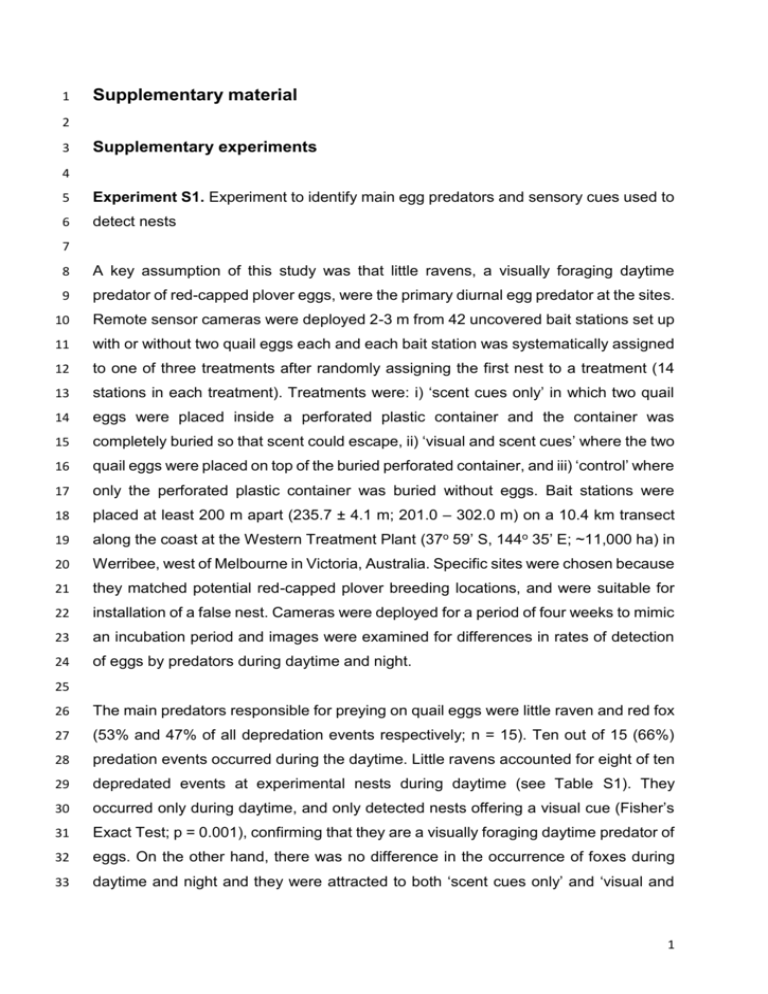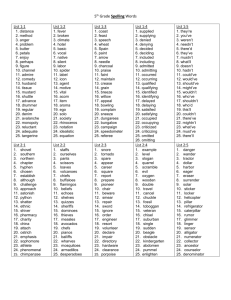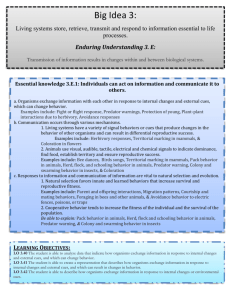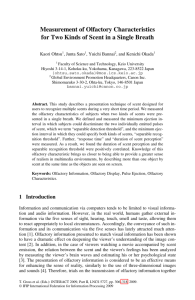
1
Supplementary material
2
3
Supplementary experiments
4
5
Experiment S1. Experiment to identify main egg predators and sensory cues used to
6
detect nests
7
8
A key assumption of this study was that little ravens, a visually foraging daytime
9
predator of red-capped plover eggs, were the primary diurnal egg predator at the sites.
10
Remote sensor cameras were deployed 2-3 m from 42 uncovered bait stations set up
11
with or without two quail eggs each and each bait station was systematically assigned
12
to one of three treatments after randomly assigning the first nest to a treatment (14
13
stations in each treatment). Treatments were: i) ‘scent cues only’ in which two quail
14
eggs were placed inside a perforated plastic container and the container was
15
completely buried so that scent could escape, ii) ‘visual and scent cues’ where the two
16
quail eggs were placed on top of the buried perforated container, and iii) ‘control’ where
17
only the perforated plastic container was buried without eggs. Bait stations were
18
placed at least 200 m apart (235.7 ± 4.1 m; 201.0 – 302.0 m) on a 10.4 km transect
19
along the coast at the Western Treatment Plant (37o 59’ S, 144o 35’ E; ~11,000 ha) in
20
Werribee, west of Melbourne in Victoria, Australia. Specific sites were chosen because
21
they matched potential red-capped plover breeding locations, and were suitable for
22
installation of a false nest. Cameras were deployed for a period of four weeks to mimic
23
an incubation period and images were examined for differences in rates of detection
24
of eggs by predators during daytime and night.
25
26
The main predators responsible for preying on quail eggs were little raven and red fox
27
(53% and 47% of all depredation events respectively; n = 15). Ten out of 15 (66%)
28
predation events occurred during the daytime. Little ravens accounted for eight of ten
29
depredated events at experimental nests during daytime (see Table S1). They
30
occurred only during daytime, and only detected nests offering a visual cue (Fisher’s
31
Exact Test; p = 0.001), confirming that they are a visually foraging daytime predator of
32
eggs. On the other hand, there was no difference in the occurrence of foxes during
33
daytime and night and they were attracted to both ‘scent cues only’ and ‘visual and
1
34
scent cues’ treatments (Fisher’s Exact Test; p = 0.19). This suggests foxes use scent
35
and possibly visual cues to detect eggs during night and daytime.
36
37
Table S1. The number of predators lured to three treatments (‘control’, ‘scent cues
38
only’ and ‘visual and scent cues’), each with 14 bait stations in the predator presence
39
and sensory cue experiment.
40
Occurrence during
Occurrence during
daytime
night
Fox
0
0
Little raven
0
0
Fox
1
4
Little raven
0
0
Fox
1
1
Little raven
8
0
Treatment
Predator
Control
Scent cues only
Visual and scent
cues
41
42
2
43
Supplementary tables
44
45
Table S2, related to Figure 3. Model selection results for the probability of clutch
46
depredation for the red capped plover (df = degrees of freedom; logLik = log likelihood;
47
AICc = AIC values adjusted for small samples; ∆i = Delta AICc; wi = model weight; D2
48
= test statistic).
49
Model
df
logLik
AICc
∆i
wi
D2
Sex * Time
4
-191.47
391.05
0.00
0.53
26.58
Sex * Time + Water
5
-191.39
392.93
1.88
0.20
26.61
Sex * Time + Vegetation
5
-191.46
393.07
2.02
0.19
26.58
Sex * Time + Vegetation + Water
6
-191.33
394.87
3.82
0.08
26.63
Sex + Time
3
-215.70
437.46
46.41
0.00
17.29
Sex + Time + Water
4
-215.64
439.38
48.33
0.00
17.31
Sex + Time + Vegetation
4
-215.69
439.47
48.42
0.00
17.29
Sex + Time + Vegetation + Water
5
-215.60
441.35
50.30
0.00
17.33
Sex
2
-229.00
462.02
70.97
0.00
12.19
Sex + Water
3
-228.95
463.95
72.91
0.00
12.21
Sex + Vegetation
3
-228.99
464.04
72.99
0.00
12.19
Sex + Vegetation + Water
4
-228.92
465.94
74.89
0.00
12.22
Time
2
-249.62
503.28
112.23
0.00
4.28
Time + Water
3
-249.19
504.44
113.40
0.00
4.45
Time + Vegetation
3
-249.25
504.57
113.52
0.00
4.42
Time + Vegetation + Water
4
-249.03
506.16
115.11
0.00
4.51
50
51
3












